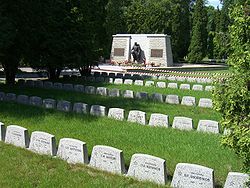- Defence Forces Cemetery of Tallinn
-
Defence Forces Cemetery of Tallinn 
The Bronze Soldier monument, "To those fallen in World War II", on the Defence Forces Cemetery of Tallinn (June 2007).Details Year established 1916 Country Estonia Location Tallinn Type Military Number of graves 1,150 The Defence Forces Cemetery of Tallinn (Estonian: Tallinna Kaitseväe kalmistu), sometimes called the Tallinn Military Cemetery, is one of the three cemeteries of the Tallinn City Centre Cemetery (Estonian: Siselinna kalmistu). It is situated about 3 kilometres outside the centre of Tallinn, the capital of Estonia. During Estonian independence before the Soviet and German occupations of the 1940-1991 period, it was the Estonian equivalent of Arlington National Cemetery in the USA - the foremost military cemetery of independent Estonia.
History
The cemetery was established in the years of World War I as the cemetery of the Tallinn garrison. The oldest grave dates back to 1916 and holds Russian, Estonian, and German soldiers killed during World War I.
The graves from 1918–1944, the gravestones of the Estonian soldiers and the monuments of the Estonian War of Independence were largely destroyed by the Soviet authorities and the graveyard was taken over by the Red Army for use by the Soviet occupation forces after World War II.[1]
The graves of fifteen British servicemen killed in the Estonian War of Independence between 1918–1920 were repaired in 1994. Her Majesty Queen Elizabeth II awarded Linda Soomre honorary Membership of the Order of the British Empire for dedication and bravery in protecting the British graves during the years of the Soviet rule. Linda Soomre was in charge of the Tallinn City Centre Cemetery for 35 years. After the destruction of the gravestones she had made the ground overnight a maintenance area saving the remains of the British soldiers from being violated.[2] Linda Soomre also saved the graves of two Estonian generals, Johan Unt and Ernst Põdder, by keeping the burial sites covered with dirt. The monument for the generals, originally opened in 1933, was restored on 22 February 1998.
The graves of the Estonian Soldiers and the demolished structure of the Estonian War of Independence monument in the graveyard are not restored. The registration book of people buried at this cemetery between years 1918–1944, with over 1,150 names, is maintained in Tallinn city central archives.
The only graves from 1918–1944 that survived the Soviet era in the graveyard was a dolomite statue in commemoration of the victims of Männiku explosion from 15 June 1936.
In mid-1990s a headstone which reads "To the Unknown Soldier: 1941–1945" in Estonian and Russian was placed on the cemetery, financed by the Russian Embassy in Estonia.
A notable monument, "To those fallen in World War II", is the Bronze Soldier, a two meter statue of a soldier in Red Army uniform with an accompanying stone structure. The statue was a part of a former Soviet World War II memorial by the sculptor Enn Roos and supervising architect Arnold Alas, and was moved from central Tallinn to the cemetery on 30 April 2007.
References
- ^ Linda Soomre Memorial Plaque at britishembassy.gov.uk
- ^ [1]
See also
- List of cemeteries in Estonia
- Bronze Soldier of Tallinn
- Military of Estonia
Coordinates: 59°25′17.76″N 24°45′55.80″E / 59.4216°N 24.7655°E
Categories:- Cemeteries in Tallinn
- Monuments and memorials in Estonia
- 1887 establishments
- History of Estonia
- Soviet military memorials and cemeteries
Wikimedia Foundation. 2010.
